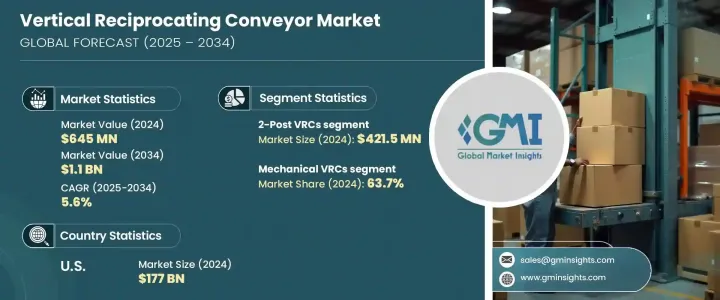
|
시장보고서
상품코드
1716694
수직 왕복 컨베이어 시장 기회, 성장 촉진 요인, 산업 동향 분석, 예측(2025-2034년)Vertical Reciprocating Conveyor Market Opportunity, Growth Drivers, Industry Trend Analysis, and Forecast 2025 - 2034 |
||||||
수직 왕복 컨베이어 세계 시장은 2024년에 6억 4,500만 달러에 이르렀고, 창고, 생산 공장, 배송 센터, 자동차, 소매 등 다양한 산업에서 첨단 자재관리 솔루션에 대한 수요 증가에 견인되어 2025년부터 2034년까지 연평균 복합 성장률(CAGR) 5.6%로 성장할 것으로 전망됩니다.
기업이 생산성을 높이고 업무 효율성을 높이고 엄격한 안전 기준을 유지하는 방법을 모색하는 동안 수직 왕복 컨베이어는 수직 재료 운송에 적합한 솔루션으로 부상하고 있습니다. VRC는 전통적인 화물 엘리베이터 및 수동 취급 시스템을 대체하는 매우 효율적이고 비용 효율적인 옵션을 제공하여 시설 내의 다른 계층간에 무거운 물체를 원활하고 안전하게 운송 할 수 있습니다.

현재 진행 중인 전자상거래의 급증은 창고 요구 증가와 함께 공간 절약 및 신뢰성 높은 리프팅 장비의 필요성을 더욱 높여 가고 있습니다. 게다가 산업 부문이 자동화와 원활한 워크플로우 관리에 중점을 두고 있는 동안, VRC는 현대 물류 인프라에 필수적이 되고 있습니다. Industry 4.0으로의 이동과 자재관리 프로세스에서 인간의 개입을 줄이는 것에 초점은 스마트 제어 기능과 강화된 안전 메커니즘을 갖춘 기술적으로 고급 VRC 시스템의 채택을 가속화하고 있습니다.
| 시장 범위 | |
|---|---|
| 시작 연도 | 2024년 |
| 예측연도 | 2025-2034년 |
| 시작금액 | 6억 4,500만 달러 |
| 예측 금액 | 11억 달러 |
| CAGR | 5.6% |
수직 왕복 컨베이어 시장의 성장을 가속하는 중요한 요인은 직장의 안전성과 규제 준수의 중요성이 높아지고 있다는 점입니다. 모든 기능을 제공하고 이러한 요구에 효과적으로 대응하는 필수적인 도구로서 눈에 띄고 있습니다. 전통적인 리프팅 방법이나 시대 지연의 컨베이어 시스템과는 달리, 최신의 VRC는 높은 신뢰성, 조작의 일관성, 진화하는 업계의 안전 규범에 준거를 보증하기 위해, 작업을 최적화하면서 노동력을 보호하는 것에 중점을 둡니다.
제품 유형별로는 2포스트 VRC가 시장을 독점하고 있으며, 2024년에는 4억 2,150만 달러를 차지했고, 2025-2034년에는 CAGR 6%로 성장할 전망입니다. 이 시스템은 최소한의 구조 발자국으로 강력한 수직 리프팅 능력을 제공하는 공간 효율적인 디자인으로 널리 선호됩니다. 견고한 자재관리 솔루션을 요구하는 중소기업(SME)에 특히 지지되어 있습니다.
운영면에서 기계식 VRC는 2024년 시장 점유율의 63.7%를 차지하며 2034년까지의 CAGR 성장률은 5.4%를 나타낼 것으로 예측됩니다. 내구성, 낮은 유지보수 필요성, 에너지 효율성으로 잘 알려진 기계식 VRC는 장기적인 운영 안정성을 우선시하는 산업에 이상적입니다. 또한 에너지 집약형 유압 시스템에 의존하지 않기 때문에 장기간에 걸쳐 비용 효율적입니다.
미국의 수직 왕복 컨베이어 시장은 2024년에 1억 7,700만 달러에 달했고, 2034년까지의 CAGR은 5.5%를 나타낼 전망이며, 자동차, 물류, 산업 제조 섹터의 확대가 주요 요인이 되고 있습니다. 미국에서 새로운 자동차 딜러와 창고가 급증하고 선진적인 자재관리 장비에 대한 수요가 계속 증가하고 있으며, VRC는 작업 요건과 안전 요건을 효율적으로 충족시키는데 있어 매우 중요한 역할을 하고 있습니다.
목차
제1장 조사 방법과 조사 범위
제2장 주요 요약
제3장 업계 인사이트
- 생태계 분석
- 밸류체인에 영향을 주는 요인
- 이익률 분석
- 혁신
- 장래의 전망
- 제조업체
- 유통업체
- 공급자의 상황
- 이익률 분석
- 주요 뉴스
- 규제 상황
- 영향요인
- 성장 촉진요인
- 산업부문에서의 자동화의 침투
- 확대하는 전자상거래 업계의 VRC에 대한 높은 수요
- 제조업 개발
- 개발도상의 건설업으로부터의 자동기계에 대한 높은 수요
- 업계의 잠재적 위험 및 과제
- 높은 이니셜 코스트
- 신흥 경제 국가의 저렴한 가격 문제
- 거액의 재무적 손실을 가져오는 기계의 다운타임
- 성장 촉진요인
- 성장 가능성 분석
- Porter's Five Forces 분석
- PESTEL 분석
제4장 경쟁 구도
- 소개
- 기업 점유율 분석
- 경쟁 포지셔닝 매트릭스
- 전략 전망 매트릭스
제5장 시장 추정 및 예측 : 제품 유형별, 2021년-2034년
- 주요 동향
- 2 포스트 VRC
- 4 포스트 VRC
제6장 시장 추정 및 예측 : 오퍼레이션별, 2021년-2034년
- 주요 동향
- 기계식 VRC
- 유압식 VRC
제7장 시장 추정 및 예측 : 용량별, 2021년-2034년
- 주요 동향
- 경량
- 대용량
제8장 시장 추정 및 예측 : 용도별, 2021년-2034년
- 주요 동향
- 창고·유통
- 제조 시설
- 군사·정부 시설
- 석유 드릴링 시설과 정유소
- 제약·화학 공장
- 식음료 가공?포장
- 인쇄·출판
- 자동차 딜러
- 호텔, 숙박 시설
- 소매·백화점
- 광업 및 건설
제9장 시장 추정 및 예측 : 유통 채널별, 2021년-2034년
- 주요 동향
- 직접
- 간접판매
제10장 시장 추정 및 예측 : 지역별, 2021년-2034년
- 주요 동향
- 북미
- 미국
- 캐나다
- 유럽
- 영국
- 독일
- 프랑스
- 이탈리아
- 스페인
- 러시아
- 아시아태평양
- 중국
- 인도
- 일본
- 한국
- 호주
- 라틴아메리카
- 브라질
- 멕시코
- 중동 및 아프리카
- UAE
- 사우디아라비아
- 남아프리카
제11장 기업 프로파일
- Advance Lifts
- Autoquip
- Beech Design and Manufacturing
- Custom Industrial Products
- Damon Australia
- Gebhardt Fordertechnik
- Industrial Kinetics
- PFlow Industries
- Qimarox
The Global Vertical Reciprocating Conveyor Market reached USD 645 million in 2024 and is projected to grow at a CAGR of 5.6% from 2025 to 2034, driven by increasing demand for advanced material handling solutions across diverse industries such as warehouses, production plants, distribution centers, automotive, and retail. As businesses seek ways to boost productivity, improve operational efficiency, and maintain stringent safety standards, vertical reciprocating conveyors are emerging as a preferred solution for vertical material transportation. VRCs offer a highly efficient and cost-effective alternative to traditional freight elevators and manual handling systems, enabling smooth and safe transportation of heavy goods between different levels within a facility.

The ongoing surge in e-commerce, coupled with rising warehousing needs, is further amplifying the need for space-saving and reliable lifting equipment. Additionally, with industrial sectors placing greater emphasis on automation and seamless workflow management, VRCs are becoming integral to modern logistics infrastructure. The shift toward Industry 4.0 and the focus on reducing human intervention in material handling processes are also accelerating the adoption of technologically advanced VRC systems equipped with smart control features and enhanced safety mechanisms.
| Market Scope | |
|---|---|
| Start Year | 2024 |
| Forecast Year | 2025-2034 |
| Start Value | $645 Million |
| Forecast Value | $1.1 Billion |
| CAGR | 5.6% |
A critical factor propelling the vertical reciprocating conveyor market growth is the rising importance of workplace safety and regulatory compliance. Industries are increasingly prioritizing the adoption of equipment that minimizes manual lifting, reduces workplace injuries, and ensures safe and smooth material movement. VRCs stand out as essential tools that address these needs effectively, offering advanced safety features such as mechanical locks, anti-fall mechanisms, and overload protection. Unlike traditional lifting methods or outdated conveyor systems, modern VRCs ensure higher reliability, operational consistency, and compliance with evolving industry safety norms, making them highly appealing to businesses focused on safeguarding their workforce while optimizing operations.
Based on product type, 2-Post VRCs dominate the market, accounting for USD 421.5 million in 2024, and are projected to grow at a CAGR of 6% during 2025-2034. These systems are widely preferred for their space-efficient designs, offering strong vertical lifting capacity with minimal structural footprint. The 2-Post VRCs are particularly favored by small and medium enterprises (SME ) seeking affordable yet robust material handling solutions. Their straightforward design, combined with certifications from regulatory authorities, makes them suitable for a wide range of industrial applications, from warehouses to automotive service centers.
In terms of operation, mechanical VRCs accounted for 63.7% of the market share in 2024 and are anticipated to witness 5.4% CAGR growth through 2034. Known for their durability, low maintenance needs, and energy efficiency, mechanical VRCs are ideal for industries that prioritize long-term operational reliability. They do not depend on energy-intensive hydraulic systems, making them cost-effective over time. Additionally, their integration of advanced safety components, including mechanical fail-safes and auto-lock features, ensures compliance with strict industrial safety mandates.
The U.S. vertical reciprocating conveyor market generated USD 177 million in 2024, with an expected 5.5% CAGR growth through 2034, largely driven by expansion in automotive, logistics, and industrial manufacturing sectors. The rapid rise of new automotive dealerships and warehouses across the country continues to boost demand for advanced material handling equipment, with VRCs playing a pivotal role in meeting operational and safety requirements efficiently.
Table of Contents
Chapter 1 Methodology & Scope
- 1.1 Market scope & definitions
- 1.2 Base estimates & calculations
- 1.3 Forecast calculations
- 1.4 Data sources
- 1.4.1 Primary
- 1.4.2 Secondary
- 1.4.2.1 Paid sources
- 1.4.2.2 Public sources
Chapter 2 Executive Summary
- 2.1 Industry synopsis, 2021-2034
Chapter 3 Industry Insights
- 3.1 Industry ecosystem analysis
- 3.1.1 Factor affecting the value chain
- 3.1.2 Profit margin analysis
- 3.1.3 Disruptions
- 3.1.4 Future outlook
- 3.1.5 Manufacturers
- 3.1.6 Distributors
- 3.2 Supplier landscape
- 3.3 Profit margin analysis
- 3.4 Key news & initiatives
- 3.5 Regulatory landscape
- 3.6 Impact forces
- 3.6.1 Growth drivers
- 3.6.1.1 Growing penetration of automation across the industrial sector
- 3.6.1.2 High demand for VRCs from the expanding e-commerce industry
- 3.6.1.3 Development of the manufacturing sector
- 3.6.1.4 High demand for automated machines from the developing construction
- 3.6.2 Industry pitfalls & challenges
- 3.6.2.1 High initial costs
- 3.6.2.2 Affordability issues in developing economies
- 3.6.2.3 Machine downtimes resulting in huge financial losses
- 3.6.1 Growth drivers
- 3.7 Growth potential analysis
- 3.8 Porter's analysis
- 3.9 PESTEL analysis
Chapter 4 Competitive Landscape, 2024
- 4.1 Introduction
- 4.2 Company market share analysis
- 4.3 Competitive positioning matrix
- 4.4 Strategic outlook matrix
Chapter 5 Market Estimates & Forecast, By Product Type, 2021-2034 (USD Million) (Thousand Units)
- 5.1 Key trends
- 5.2 2-Post VRCs
- 5.3 4-Post VRCs
Chapter 6 Market Estimates & Forecast, By Operation, 2021-2034 (USD Million) (Thousand Units)
- 6.1 Key trends
- 6.2 Mechanical VRCs
- 6.3 Hydraulic VRCs
Chapter 7 Market Estimates & Forecast, By Capacity, 2021-2034 (USD Million) (Thousand Units)
- 7.1 Key trends
- 7.2 Light capacity
- 7.3 Heavy capacity
Chapter 8 Market Estimates & Forecast, By Application, 2021-2034 (USD Million) (Thousand Units)
- 8.1 Key trends
- 8.2 Warehouse and distribution
- 8.3 Manufacturing facility
- 8.4 Military & government facility
- 8.5 Oil rigs and refineries
- 8.6 Pharmaceutical/chemical plants
- 8.7 Food & beverage processing & packaging
- 8.8 Printing & publication
- 8.9 Automotive dealership
- 8.10 Hotels & lodging
- 8.11 Retail & department stores
- 8.12 Mining and construction
Chapter 9 Market Estimates & Forecast, By Distribution Channel, 2021-2034 (USD Million) (Thousand Units)
- 9.1 Key trends
- 9.2 Direct
- 9.3 Indirect
Chapter 10 Market Estimates & Forecast, By Region, 2021-2034 (USD Million) (Thousand Units)
- 10.1 Key trends
- 10.2 North America
- 10.2.1 U.S.
- 10.2.2 Canada
- 10.3 Europe
- 10.3.1 UK
- 10.3.2 Germany
- 10.3.3 France
- 10.3.4 Italy
- 10.3.5 Spain
- 10.3.6 Russia
- 10.4 Asia Pacific
- 10.4.1 China
- 10.4.2 India
- 10.4.3 Japan
- 10.4.4 South Korea
- 10.4.5 Australia
- 10.5 Latin America
- 10.5.1 Brazil
- 10.5.2 Mexico
- 10.6 MEA
- 10.6.1 UAE
- 10.6.2 Saudi Arabia
- 10.6.3 South Africa
Chapter 11 Company Profiles
- 11.1 Advance Lifts
- 11.2 Autoquip
- 11.3 Beech Design and Manufacturing
- 11.4 Custom Industrial Products
- 11.5 Damon Australia
- 11.6 Gebhardt Fordertechnik
- 11.7 Industrial Kinetics
- 11.8 PFlow Industries
- 11.9 Qimarox



















